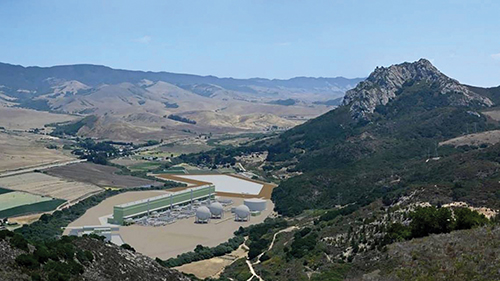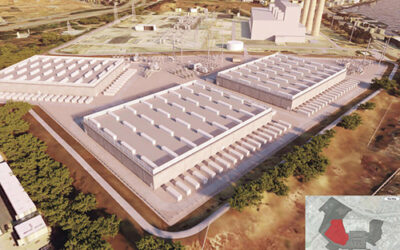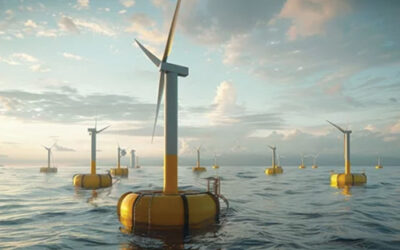Here’s a rendering of what Hydrostor’s proposed Pecho Energy Storage Center in Chorro Valley would look like from Cerro Cabrillo. The big mountain to the right is Hollister Peak. Photo courtesy Hydrostor
A proposed innovative energy storage system being eyed for Chorro Valley appears to be running out of juice, as the company trying to get it built is pausing to look at its options.
Meanwhile, a recent news report said the so-named “Pecho Energy Center Project (Pecho Project) had been dropped by Hydrostor, the Canadian company that invented the “Advanced Compressed Air Energy Storage” or A-CAES system and wants to build one here.
Won’t Confirm or Deny
Estero Bay News sought to confirm this development with Hydrostor, asking the media office if the news account was correct and they’d abandoned the Pecho project?
Curt Hildebrand, Hydrostor’s Senior Vice President of Commercial Affairs replied, “Hydrostor is examining options to optimize the site location. We continue to explore alternative options to develop an energy storage resource to serve the Central Coast community.
“Thank you for your continued interest in Hydrostor and our development activities in San Luis Obispo County.”
He added that they had not released any information about this but the non-committal answer is telling.
EBN also sought confirmation from the California Energy Commission but couldn’t find anything about dropping the project in its considerable docket (files) on the project. We sent injuries to their media office, which didn’t respond by deadline.
So while opponents of the Pecho Project can breathe a bit easier for now, we can’t confirm the proposal is officially dead.
Innovative Project
In essence, the 400-megawatt plant would use a new technology that Hydrostor invented and is trying to build at several locations, including off Hwy 1 at Dana Road, at the foot of Hollister Peak.
How it works is that giant compressors pump a mix of air and water into pressure tanks buried deep underground using excess energy produced when both wind and solar power are over-abundant.
The pressurized tanks store that extra energy and can release it over time, pushing it through turbine/generators and sending the electricity back onto the power grid for when energy supply from wind and solar drops.
“The state-of-the-art Project,” Hydrostor said in a news release from its November 2021 project launch, “will provide large-scale, long-duration energy storage for the region with no fossil fuel consumption and no greenhouse gas emissions. With commercial operation date as early as 2026, Pecho will play a vital role in helping meet the region’s future energy supply and reliability needs after the retirement of the 2,200 MW Diablo Canyon Power Plant in 2024/2025.”
Wishful Thinking
That quick goal of 2026 would seem to have been at best wishful thinking as the project was met immediately with opposition by neighbors of the proposed site who live in the scenic and very rural Chorro Valley.
Some families in the area of Hollister Peak have been there for generations and the bottomland is actively farmed. Hydrostor wants to build on 300-acres of farmland.
The project included a nearly 70,000-square foot, 100-feet tall, generator/compressor building and other buildings, too.
It would also require a lot of groundwater to fill a 40-foot deep reservoir covering some 27 acres.
Water Worries
It was the water usage that worried neighbors most, as everyone out that way is on water wells. Chorro Valley was always a reliable source of groundwater for the City of Morro Bay, which used to draw the majority of its drinking water out of a handful of wells out there.
Those wells reliably produced over 950-acre feet a year for the City until 2006, when the State Water Project arrived and replaced the Chorro well field. Most of the City wells haven’t been used in years.
The City has now abandoned all but one of the Chorro wells after deciding it didn’t want to pursue a prescriptive rights permit from the State or rehab the wells, which had fallen into disrepair.
The sticking point was always Chorro Creek and a State Water Quality Control Board permit requirement that stopped pumping by the City whenever the creek flow drops below 1.4 cubic feet per second, about the strength of a low-flow showerhead.
The State wanted a stream gauge installed to monitor the creek flow and for several reasons, the City decided to abandon the well field instead, keeping just one in operation off Dana Road.
It’s unclear if the Pecho Project was going to be held to that same standard, as the project hasn’t gotten that far.
Water quality out there has at times run high in nitrates (salt) and turbidity was high back when the City actually used that water and tracked the well levels and quality weekly.
Retired former Morro Bay Public Works Director, Bill Boucher, once declared at a City Council meeting that the Chorro Valley water looked “like Yoo-hoo Soda.”
Use City Wastewater
In its initial comments on the project, the Regional Water Quality Control Board in SLO suggested that the plant switch water sources and use recycled water from the new Morro Bay Water Resources Center, which is a fair distance away from Hydrostor’s project site. The City’s new plant treats sewage to a tertiary level and micro-filters the wastewater before discharge or recycling it.
The water board’s suggestion was scoffed at by City officials, who said they’d never been approached about this by the company nor the water board. And their highly treated wastewater is intended to be recycled by the City to support the drinking water supply.
High Voltage Shock
Hydrostor’s desire to connect to the high voltage power lines that run from Diablo Canyon to Morro Bay and cross Chorro Valley near to the project site, also got a shock when the State and Federal Governments decided they wanted Diablo Canyon to continue operating for another 5-10 years after the announced 2025 closure.
The supply of emissions-free energy isn’t going to be where it needs to be in order to remove Diablo Canyon’s steady power from the grid.
That’s sent PG&E back to the Nuclear Regulatory Commission’s drawing board with regards to re-licensing, a process that had already taken a decade before it was dropped.
PG&E is now working on both re-licensing the plant to extend operations and planning on its eventual decommissioning.
All this Diablo intrigue happened after Hydrostor began pursuing its project and could be a big reason Hydrostor is looking at its options.




